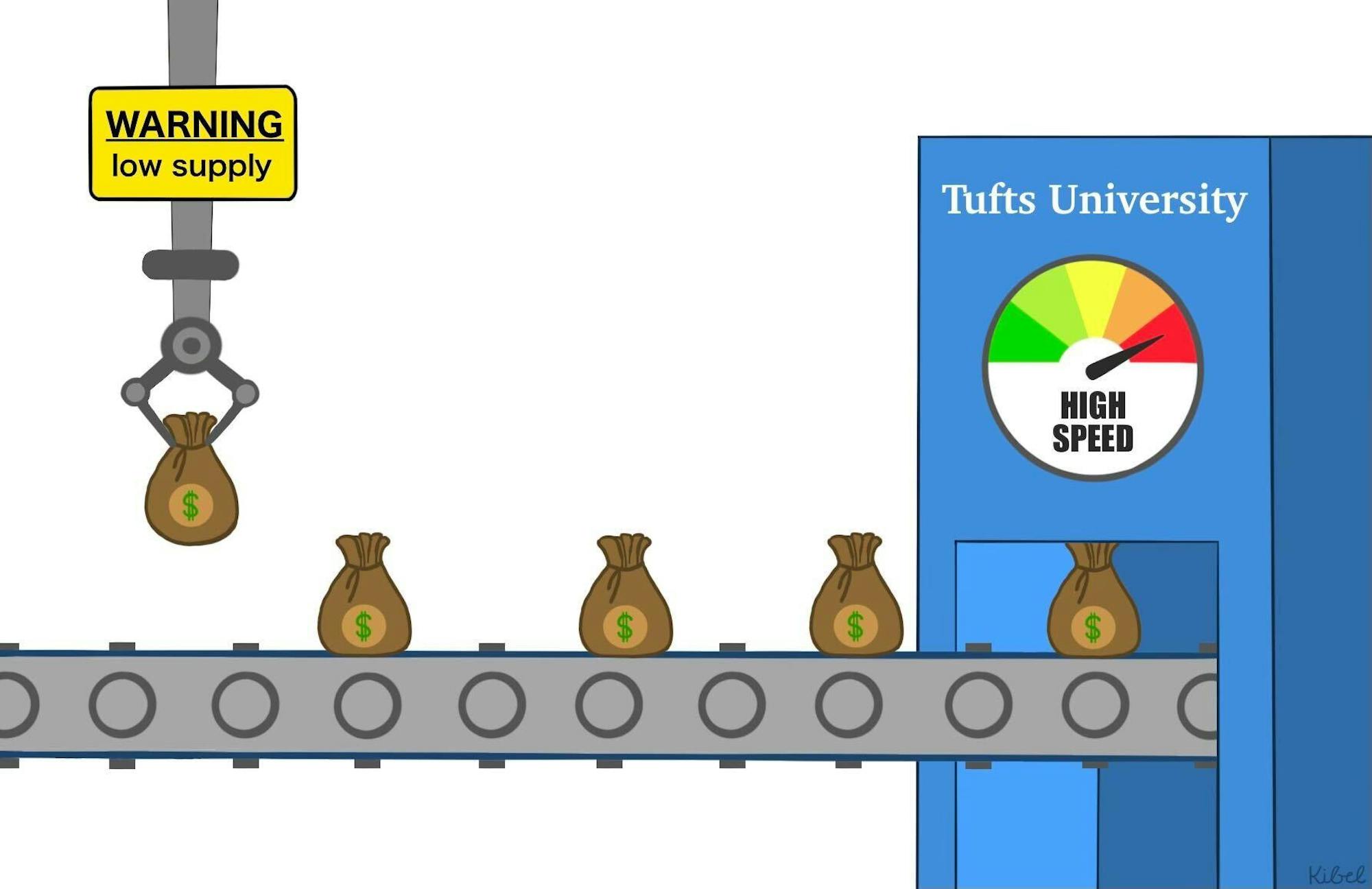Editor’s note: This is the second article in a two-part series. Read the first part here.
In our last article, we explained the reasons for and ramifications of Tufts’ high tuition. But how can we lower it? The solution is raising money and better focusing funds. In speaking with Jim Hurley, vice president for finance and treasurer, and Mike Howard, executive vice president, it is clear that there is a correlation between increased donations and reduced pressure on the importance of tuition dollars. However, even if fundraising efforts accelerate, Tufts will not be entirely out of the woods. Tufts’ financial troubles, while deserving of sympathy, are partly due to poorly conceived university initiatives and policies.
One organizational dilemma is that Tufts does not appear to have a clear grasp of where it wants to reside within the wider higher education landscape. Tufts purports to have “the resources of a major research university and the attention of a liberal arts college.” However, judging from immense STEM funding in the form of grants, scholarships and new facilities, this split is far from even. Furthermore, Tufts’ divided focus is a factor in high tuition. Tufts lacks the funds to fully realize this vision of doing both. For example, 17% of Tufts-sponsored research, grants and contracts go to the School of Engineering, while only 11% go to the School of Arts and Sciences. This perplexes us, seeing that engineering students make up only 18%–19% of the Tufts arts, sciences and engineering community.
In 2019, addressing whether Tufts was a research or liberal arts institution, then-dean of the School of Engineering Jianmin Qu said that, “Tufts happens to be somewhere in the middle. We consider ourselves to be one of the smaller schools, … but we also offer a research-intensive environment for our undergrads,” adding that “We don’t have a large number of undergrads to support that research infrastructure, so if you look at it that way, it is not too surprising that our finances make it very difficult to offer the best of both.”
As Tufts continues to buttress STEM programs and research, it has simultaneously taken steps to eat away at the liberal arts infrastructure: In 2021, Tufts decided to end the Portuguese program. This move could be a pretext for further program cuts and fewer liberal arts offerings. It further calls into question whether Tufts is indeed a liberal arts institution that honors humanities, social sciences and language studies. In his article for the Daily, “Is there a future for Tufts?,” Toby Winick noted that “low-income students … more often choose to study STEM fields that can lead to higher incomes,” a trend that may be particularly strong at Tufts, with our high tuition saddling students with loan debt. This shift has clearly influenced Tufts to favor STEM programs over liberal arts. This further corresponds to projects undertaken and completed by Tufts, including the Science and Engineering Complex and the Joyce Cummings Center, both of which primarily serve STEM students.
Tufts cannot continue pushing for this binary if it wants to stabilize tuition. The financial cost put on students worsens each year because the university continues to push a research focus it can’t fully afford considering its small endowment. Tufts has reached a crossroads and needs to choose a path that benefits everybody.
Hurley and Howard spoke in depth about another key factor that drives up Tufts tuition — under-enrollment in masters programs, an issue affecting universities nationally. According to the National Student Clearinghouse Research Center, “graduate-level enrollment drops are almost entirely due to losses in master’s programs,” which amounts to 57,000 students nationwide. Hurley and Howard outlined how declining enrollment in Tufts masters programs — such as at Fletcher and Tufts Medical School, both of which are currently losing money — will trickle down to undergraduate students in the form of higher tuition, as the income attributed to master programs tuition contributes heavily to funding the undergraduate program. Tufts needs to bolster its graduate schools to prevent tuition from continuing to increase.
The most prominent financial issue Tufts faces is that revenue is more uncertain than expenses. This will become even more apparent if university fundraising efforts don’t resonate with parents, alumni and friends of Tufts. The recently completed Brighter World campaign should serve as a model for Tufts’ fundraising initiatives moving forward. The $1.5 billion capital raise was hugely successful, and Tufts should implement the same strategy for future campaigns that are directed exclusively towards financial aid, tuition reduction, professor salaries and general university needs. Strategic fundraising to augment the endowment is the key to ensuring Tufts’ long-term success and lowering tuition.
Additionally, in doing research for this article, we found it very challenging to acquire information related to tuition and financial aid. Our questions were clarified through a meeting with Hurley, Howard, Chief Investment Officer Craig Smith and Executive Director of Media Relations Patrick Collins. While they were able to provide context and information that helped answer our questions, it should have been much easier to come across the relevant information online. Tufts’ current and prospective students deserve clear information on tuition and how their money is being used. We encourage Tufts to do a better job disclosing information related to tuition.





